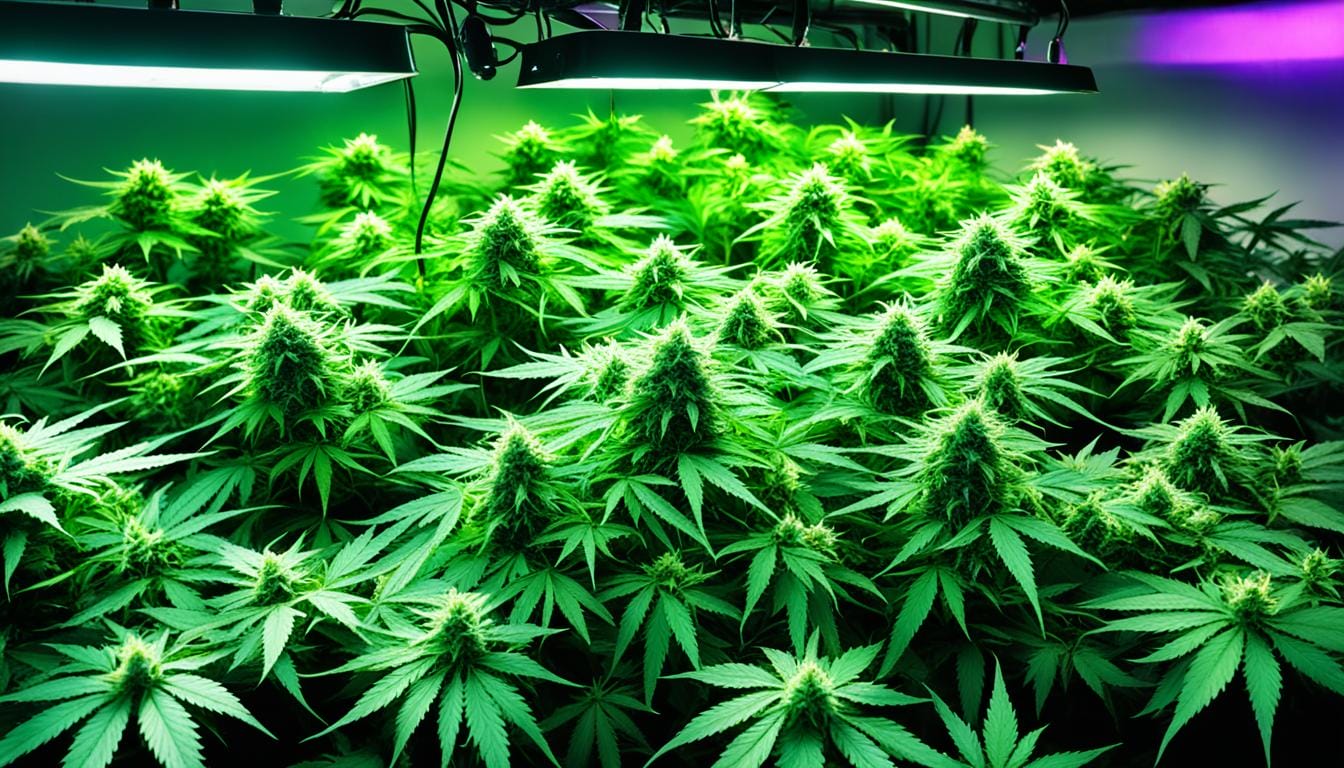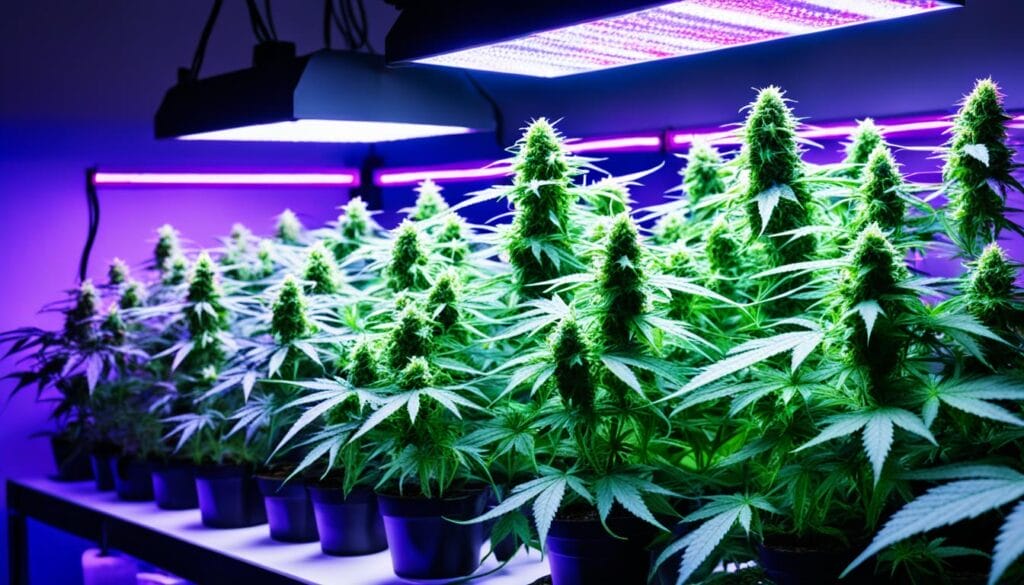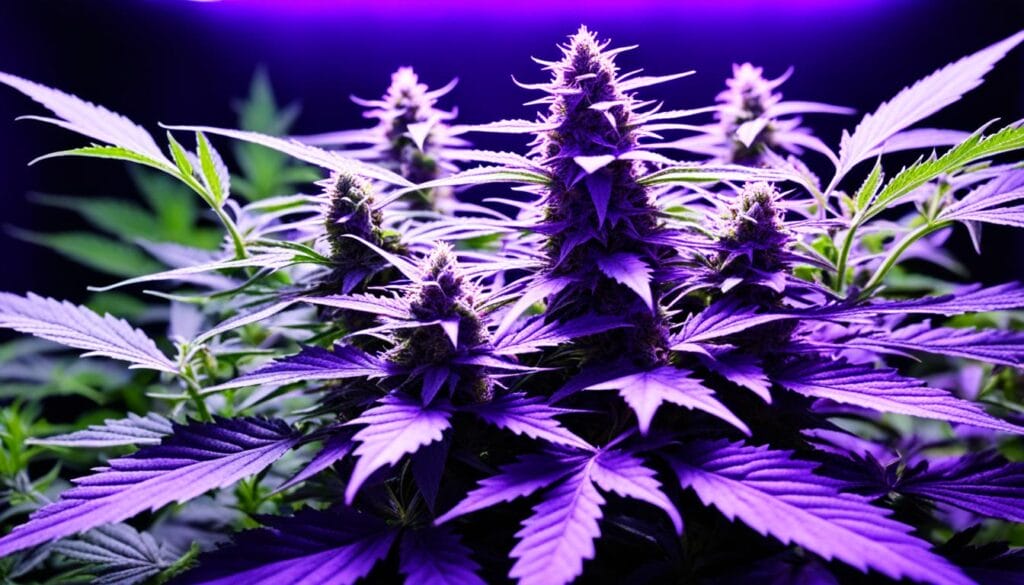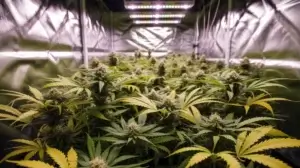Optimal Lighting Needs for Cannabis Growth

Did you know that the right lighting can make or break the success of your cannabis plants? In fact, the lighting needs of cannabis are so specific that they can directly impact the health, growth, and potency of your plants. Whether you are a seasoned grower or just starting out, understanding the importance of lighting in cannabis cultivation is key to achieving optimal results.
This article will delve into the essential lighting needs for successful cannabis growth to help you navigate the world of cannabis grow lights. We will explore the different types of grow lights commonly used, including the increasingly popular LED grow lights. By understanding and meeting your cannabis plants’ lighting requirements, you can set the stage for healthier plants and better yields.
Key Takeaways:
- Proper lighting is crucial for successful cannabis growth and can directly impact plant health, growth, and potency.
- Understanding the different types of grow lights, including LED grow lights, is essential for selecting the right lighting option for your cannabis garden.
- Factors such as light intensity, duration, and spectrum play a vital role in meeting the specific lighting requirements of cannabis plants.
- A well-designed grow light setup is necessary for maximizing cannabis growth, and proper positioning, distance, and ventilation should be considered.
- Flowering is a critical stage in cannabis growth, and adjusting lighting conditions appropriately can promote healthy bud development.
Understanding Cannabis Lighting Requirements
To optimize cannabis growth, it’s crucial to understand the specific lighting requirements of marijuana plants. The right lighting conditions can significantly impact the quality, yield, and overall health of your cannabis crops. In this section, we will delve into the various factors that influence the lighting needs of cannabis, including light intensity, duration, and spectrum.
Light Intensity: Cannabis plants require adequate light intensity for optimal photosynthesis. The right amount of light ensures energy production and nutrient absorption, promoting healthy growth. Insufficient light can result in weak plants with sparse foliage. On the other hand, excessive light can cause light burn, stunting the growth and development of your cannabis plants.
Light Duration: The duration of light exposure also plays a crucial role in cannabis growth. During the vegetative stage, cannabis plants typically require 18 to 24 hours of light per day to maintain rapid growth and development. In contrast, during the flowering stage, it’s essential to provide 12 hours of uninterrupted darkness to trigger bud formation. Maintaining a consistent lighting schedule is key to ensuring healthy transitions between growth stages.
Light Spectrum: The spectrum of light emitted by grow lights affects different aspects of cannabis growth. Different wavelengths of light influence various plant processes, such as chlorophyll production, stem elongation, and flowering. Utilizing the right light spectrum during different growth stages can enhance specific characteristics like leaf development, compact bud formation, and terpene production.
The Role of Blue and Red Light
During the vegetative stage, cannabis plants benefit from higher levels of blue light (400-500 nm). Blue light stimulates vegetative growth, promoting strong, healthy foliage and root development. As plants transition into the flowering stage, red light (620-780 nm) becomes more important. Red light facilitates the production of larger and denser blooming sites, leading to bigger and higher-quality buds.
Did You Know?
Cannabis plants can also benefit from other spectrums of light, such as ultraviolet (UV) and far-red light. UV light helps stimulate resin production and enhances the plant’s defense mechanisms. Far-red light promotes flowering and increases overall cannabinoid production.
Understanding and meeting the lighting requirements of cannabis plants will empower you to create an ideal environment for growth. By providing the right light intensity, duration, and spectrum, you can cultivate healthy, productive, and potent cannabis plants.
Stay tuned for the next section, where we will discuss the importance of grow light spectrum for cannabis growth.
Importance of Grow Light Spectrum for Cannabis
When it comes to growing cannabis, the spectrum of light emitted by grow lights plays a crucial role in the plant’s overall health and development. Each stage of the cannabis plant’s lifecycle requires a different light spectrum to maximize growth and yield. Understanding and optimizing the grow light spectrum can significantly enhance the quality and quantity of your cannabis harvest.
The two primary types of grow light spectrums used in cannabis cultivation are the vegetative spectrum and the flowering spectrum. During the vegetative stage, cannabis plants require a light spectrum rich in blue wavelengths, which promotes healthy leaf development and strong stems. On the other hand, during the flowering stage, cannabis plants thrive under a light spectrum high in red wavelengths, which stimulates bud production and encourages robust flowering.
It is essential to note that cannabis plants also benefit from a full spectrum of light, which includes a combination of blue, red, and other wavelengths. Some growers opt for full-spectrum LED grow lights, as they provide a balanced light spectrum that closely mimics natural sunlight, allowing for optimal photosynthesis and overall plant health.
“The right grow light spectrum can make a significant difference in the growth, quality, and yield of your cannabis plants.”
The Benefits of Different Light Spectrums
Here is a breakdown of the benefits different light spectrums offer during various stages of cannabis growth:
| Stage of Growth | Light Spectrum | Benefits |
|---|---|---|
| Vegetative | Blue spectrum | Promotes leaf development, strong stems, and overall plant structure |
| Flowering | Red spectrum | Stimulates bud production, enhances flowering, and increases resin production |
| Full Spectrum | Combination of blue, red, and other wavelengths | Provides a balanced spectrum for optimal photosynthesis and overall plant health |
By understanding the specific light spectrum needs during each stage of growth, you can fine-tune your grow light setup to provide the ideal conditions for your cannabis plants, resulting in healthier plants and better yields.
Choosing the Best Grow Lights for Cannabis
When it comes to growing cannabis, selecting the best grow lights is an essential decision that directly impacts the health and productivity of your plants. With a wide variety of options available on the market, it can be overwhelming to choose the right one. In this section, we will explore different types of grow lights and provide recommendations based on key factors such as efficiency, coverage, and cost-effectiveness.
Types of Grow Lights
There are three main types of grow lights commonly used for cannabis cultivation:
- LED Grow Lights
- High-Intensity Discharge (HID) Lights
- Fluorescent Lights
While each type has its advantages and disadvantages, LED grow lights have gained immense popularity among growers for their energy efficiency, longer lifespan, and customizable light spectrums. They are specifically designed to provide the perfect lighting conditions for cannabis plants throughout their growth stages.
Recommended LED Grow Lights
Below are some of the best LED grow lights for cannabis, recommended by experienced growers:
| LED Grow Light | Efficiency | Coverage Area | Price Range |
|---|---|---|---|
| Mars Hydro TS 1000 | Up to 2.2 μmol/J | 2′ x 2′ (61cm x 61cm) | $139 – $159 |
| Horticulture Lighting Group HLG 550 V2 | Up to 3.0 μmol/J | 4′ x 4′ (122cm x 122cm) | $849 – $999 |
| Spider Farmer SF-4000 | Up to 2.9 μmol/J | 4′ x 4′ (122cm x 122cm) | $649 – $769 |
These LED grow lights are known for their efficiency, wide coverage area, and value for money. They provide the perfect balance of light intensity, spectrum, and performance, resulting in healthier plants and higher yields.
When choosing the best grow lights for cannabis, consider factors like the size of your growing space, the number of plants, and your budget. Additionally, be sure to check the manufacturer’s specifications and customer reviews to make an informed decision.

Investing in high-quality grow lights is a long-term investment that directly contributes to the success of your cannabis garden. In the next section, we will guide you through setting up an effective marijuana grow light system to optimize your plants’ growth and development.
Setting up an Effective Marijuana Grow Light Setup
Proper grow light setup is crucial for maximizing cannabis growth. Setting up your indoor lighting system correctly ensures that your plants receive the right amount and quality of light for optimal development. In this section, we will guide you through the essential steps of setting up a marijuana grow light system, including important considerations such as light position, distance, and ventilation.
Light Position
The position of your grow lights plays a vital role in providing uniform lighting coverage for your cannabis plants. To achieve an even distribution of light, hang your grow lights in a way that provides adequate coverage across the entire canopy. For small to medium-sized plants, hanging the lights directly above the plants, a few inches away from the top of the canopy, is recommended. It allows the plants to receive maximum light intensity without burning the foliage.
Light Distance
The distance between your grow lights and the top of your plants is crucial in preventing light burn or light stress. Different grow lights have varying intensity levels, so it’s important to refer to the manufacturer’s guidelines for recommended hanging distances. As a general rule, start with the lights positioned higher and gradually lower them to find the optimum distance for your specific grow light setup and cannabis strain. Keep a close eye on your plants’ foliage and adjust the distance accordingly to prevent any light-related issues.
Ventilation
Adequate ventilation is essential to ensure healthy airflow and prevent heat buildup in your grow room. Proper air circulation helps maintain the appropriate temperature and humidity levels, ensuring your plants thrive. Consider installing inline fans or air exchange systems to create a constant flow of fresh air and remove excess heat. Additionally, using oscillating fans within the grow space can help strengthen plant stems and prevent mold or mildew formation.
Proper positioning, the right distance, and effective ventilation are key elements in setting up an efficient marijuana grow light system. By ensuring uniform light coverage, preventing light burn, and maintaining optimal airflow, you can provide your cannabis plants with the best possible growing conditions, leading to healthier and more productive yields.
Now that you have a clear understanding of how to set up an effective marijuana grow light system, it’s time to put your knowledge into practice. Follow the guidelines mentioned above to create an ideal lighting environment for your cannabis plants to thrive.
| Benefits of an Effective Marijuana Grow Light Setup |
|---|
| Provides consistent light coverage |
| Prevents light burn or stress |
| Ensures optimal airflow and temperature |
| Promotes healthier and more productive yields |
The Role of Lighting in Cannabis Flowering
Flowering is a critical stage in cannabis growth, and the right lighting plays a crucial role in promoting healthy and abundant bud development. When it comes to the flowering stage, using the correct grow light for cannabis is essential to ensure optimal results.
During this phase, the plant transitions from the vegetative stage to producing flowers, and its lighting requirements change accordingly. Cannabis plants need specific light spectrums and intensities to trigger and support flowering.
One key factor to consider when selecting a grow light for cannabis flowering is the spectrum it emits. The light spectrum influences various aspects of the flowering process, including bud size, resin production, and terpene profiles.
LED grow lights are particularly popular for cannabis flowering due to their ability to provide a wide range of adjustable spectrums. They allow growers to customize the light output to match the specific needs of their plants during different stages of flowering.
Another important consideration is the light intensity. Cannabis plants require different light intensities during different phases of flowering. By adjusting the light intensity, growers can optimize bud development and prevent issues such as light burn or stretched plants.
It’s crucial to position grow lights correctly to maximize their effectiveness during the flowering stage. Placing the lights at the proper distance from the canopy ensures that the plants receive an even distribution of light. It’s also important to monitor and adjust the lighting setup regularly as the plants grow to maintain the ideal conditions.
Here’s a quick checklist for optimizing your grow light setup during the flowering stage:
- Choose a grow light with adjustable spectrum options
- Adjust the light intensity to match the plant’s needs
- Position the lights at the correct distance from the canopy
- Monitor and adjust the lighting setup as the plants grow
- Regularly inspect and clean the grow light fixtures to maximize efficiency
“During the flowering stage, providing the right lighting conditions is crucial for maximizing bud development and overall yield.” – Cannabis Grower
By understanding and meeting the specific lighting needs of cannabis plants during the flowering stage, growers can ensure healthier plants and achieve impressive yields. The right grow light, combined with proper spectrum adjustment, light intensity, and positioning, allows cannabis enthusiasts to witness the full potential of their beloved plants.

Advanced Techniques for Cannabis Lighting
For experienced growers, mastering advanced lighting techniques is the key to unlocking the full potential of your indoor cannabis garden. These techniques can significantly enhance the growth and yield of your plants, resulting in healthier plants and better yields.
Light Cycling
One advanced technique that experienced growers employ is light cycling. Light cycling involves manipulating the hours of light and darkness in a 24-hour cycle to simulate specific stages of the plant’s life cycle. By fine-tuning the lighting schedule, growers can optimize growth, flowering, and fruiting, leading to improved yields and quality.
Light Intensity Manipulation
Controlling the intensity of light is another technique that can take your cannabis cultivation to the next level. By adjusting the brightness of your grow lights during different stages of growth, you can mimic natural sunlight and influence plant development. Higher light intensities during the vegetative stage encourage robust growth, while lower intensities during the flowering stage promote the formation of dense buds.
Supplemental Lighting
In some cases, supplemental lighting can complement your existing grow light setup and provide additional benefits. Supplemental lighting involves using specific types of lights, such as UV or far-red lights, alongside your primary grow lights. These supplemental lights target specific wavelengths that can enhance plant metabolism, stimulate resin production, and optimize overall growth.
“With advanced lighting techniques like light cycling, light intensity manipulation, and supplemental lighting, you have the power to create a custom environment that maximizes your cannabis plants’ potential.” – Ryan Smith, experienced cannabis grower
To maximize these advanced techniques, it’s crucial to monitor your plants closely and adjust based on their response. Experimentation and fine-tuning will help you discover the optimal grow light setup for your specific strains and growing conditions.
| Advanced Technique | Benefits |
|---|---|
| Light Cycling | Simulates specific stages of the plant’s life cycle, optimizing growth and flowering |
| Light Intensity Manipulation | Influences plant development and promotes robust growth during the vegetative stage and dense bud formation during flowering |
| Supplemental Lighting | Targets specific wavelengths to enhance plant metabolism, resin production, and overall growth |
By incorporating these advanced techniques into your cannabis lighting setup, you can create the ideal conditions for your plants to thrive. Remember to observe and adjust as needed, and soon you’ll be reaping the rewards of your advanced grow light knowledge.
LED Grow Lights vs. Other Lighting Options
LED grow lights have become increasingly popular among cannabis growers in recent years. Their energy efficiency and customizable light spectrums make them a preferred choice for indoor cultivation. Let’s compare LED grow lights to other lighting options to understand why they are favored by many growers.
Pros of LED Grow Lights
- Energy Efficiency: LED grow lights consume less electricity compared to traditional lighting options, resulting in lower energy costs and reduced environmental impact.
- Customizable Light Spectrums: LED grow lights allow growers to tailor the light spectrum according to the specific needs of their cannabis plants. This customization enhances plant growth and yield.
- Long Lifespan: LED grow lights have a longer lifespan compared to other lighting options, reducing the need for frequent replacements and maintenance.
- Low Heat Generation: LED grow lights produce minimal heat, preventing heat-related damage to the plants and reducing the need for additional cooling systems.
Cons of LED Grow Lights
- Higher Initial Cost: LED grow lights tend to have a higher upfront cost compared to other lighting options. However, the long-term savings in energy consumption and maintenance costs often outweigh the initial investment.
- Availability of Quality Products: Due to the increasing demand for LED grow lights, it is important to carefully research and choose reliable brands to ensure high-quality products that deliver optimal performance.
In comparison to other lighting options like fluorescent, HID (High-Intensity Discharge), and CMH (Ceramic Metal Halide) lights, LED grow lights offer a range of advantages that make them a preferred choice for cannabis cultivation. Their energy efficiency, customizable spectrum, and longer lifespan contribute to healthier plants and better yields.
Tips for Maintaining Healthy Lighting Conditions
Maintaining proper lighting conditions is crucial for healthy cannabis growth. By following these essential tips, you can ensure that your indoor lighting setup remains in optimal condition to support the growth and development of your marijuana plants.
1. Monitor Light Intensity:
Regularly monitor the intensity of your indoor lighting to ensure it meets the specific needs of your cannabis plants. Too much or too little light can have adverse effects on growth and overall health. Use a light meter to measure the intensity and make adjustments accordingly.
2. Follow a Consistent Schedule:
Establish a consistent lighting schedule for your marijuana plants. Cannabis requires a specific amount of light each day, with variations depending on the growth stage. Create a schedule that mimics the natural light cycle to promote healthy development.
3. Clean Your Grow Lights:
Regularly clean your grow lights to remove dust, dirt, and any other particles that can obstruct light output. Dirty lights can reduce intensity and efficiency, impacting plant growth. Use a soft cloth or a gentle cleaning solution to wipe down the lights, ensuring they shine brightly.
4. Rotate Plants:
Regularly rotate your cannabis plants to promote even light distribution and prevent uneven growth. This helps ensure that all parts of the plant receive adequate light exposure, leading to more consistent growth and higher yields.
5. Provide Adequate Ventilation:
Proper ventilation is crucial for maintaining healthy lighting conditions. Ensure that your indoor grow space has adequate airflow to prevent heat build-up, which can damage plants and affect light effectiveness. Install fans or an exhaust system as needed.
“Maintaining optimal lighting conditions is key to successful cannabis cultivation. By monitoring light intensity, following a consistent schedule, cleaning grow lights, rotating plants, and providing adequate ventilation, you can create an ideal environment for healthy growth.” – James Bean
Remember, every grow setup is unique, so it’s essential to observe your plants and make adjustments accordingly. By understanding and implementing these tips, you can optimize your indoor lighting for healthy and thriving marijuana plants.
Conclusion
Understanding and meeting the lighting needs of cannabis plants are fundamental for achieving successful growth and higher yields. By selecting the right grow lights, optimizing light spectrums, and implementing effective lighting setups, you can master the art of cannabis cultivation.
Choosing the best grow lights for your indoor garden is crucial. LED grow lights offer numerous advantages, such as energy efficiency and customizable light spectrums, making them a popular choice among cannabis growers. However, it’s important to consider factors like efficiency, coverage, and cost-effectiveness when making your selection.
Additionally, proper lighting setup is essential for promoting healthy bud development during the flowering stage. Adjusting the light position, distance, and ventilation can significantly impact the outcome of your harvest. Advanced lighting techniques, such as light cycling and intensity manipulation, can further enhance plant growth and yield for experienced growers.
Maintaining healthy lighting conditions is also key to successful cannabis cultivation. To keep your plants thriving, regularly monitor light intensity, schedule consistent lighting cycles, and ensure proper cleaning of your indoor lighting system.
FAQ
What are the optimal lighting needs for cannabis growth?
Cannabis plants require specific lighting conditions to thrive. They need a minimum of 18 hours of light during the vegetative stage and 12 hours of light during the flowering stage. The optimal light intensity should be around 600 to 1000 PAR (photosynthetically active radiation). LED grow lights are commonly used due to their energy efficiency and customizable light spectrums.
What are the lighting requirements for cannabis?
Cannabis plants require a balance between light intensity, duration, and spectrum. During the vegetative stage, they need higher light intensities of around 600 to 1000 PAR for robust growth. When transitioning to the flowering stage, reducing the light duration to 12 hours and adjusting the light spectrum to include more red and far-red light promotes bud development.
How does the grow light spectrum affect cannabis growth?
The spectrum of light emitted by grow lights has a significant impact on cannabis growth. Blue light promotes vegetative growth and compact plants, while red light stimulates flowering and bud production. Full-spectrum LED grow lights provide a balanced spectrum that covers the entire range of light wavelengths needed for cannabis growth.
What are the best grow lights for cannabis?
LED grow lights are highly recommended for cannabis cultivation. They are energy-efficient, produce less heat, and are customizable to provide the optimal spectrum for each stage of plant growth. Some popular LED grow light brands for cannabis include Mars Hydro, Spider Farmer, and Grow Light Science.
How do I set up an effective marijuana grow light system?
Setting up a marijuana grow light system involves positioning the lights at the appropriate distance from the plants to ensure sufficient coverage. The lights should be hung using adjustable hangers and maintained at the recommended distance based on the light intensity and plant growth stage. Adequate ventilation and airflow around the lights are also crucial to prevent heat buildup.
How can lighting be optimized for cannabis flowering?
To optimize cannabis flowering, adjust the lighting setup by reducing the light duration to 12 hours per day. Increase the amount of red and far-red light in the spectrum to promote bud development. It’s essential to ensure a consistent dark period during the flowering stage to avoid light interruptions, as this can negatively affect flowering and resin production.
Are there any advanced techniques for cannabis lighting?
Yes, experienced growers can implement advanced techniques to further enhance cannabis growth. Light cycling involves alternating periods of light and darkness throughout the day to mimic natural outdoor conditions. Light intensity manipulation allows growers to fine-tune light levels for specific stages of growth. Supplemental lighting can also be used to provide additional light when natural light is limited.
What are the advantages of LED grow lights compared to other lighting options?
LED grow lights offer numerous advantages for cannabis cultivation. They are energy-efficient, producing less heat and consuming less electricity. LED lights can also be customized to provide the optimal light spectrum for each growth stage. Additionally, they have a longer lifespan, reducing the need for frequent replacements compared to other lighting options such as HID (high-intensity discharge) lamps.
How can I maintain healthy lighting conditions for my indoor cannabis plants?
To maintain healthy lighting conditions, regularly monitor the light intensity using a light meter to ensure it falls within the optimal range for cannabis growth. Create a consistent lighting schedule and stick to it, maintaining the recommended light duration for each growth stage. Cleaning the grow lights and reflectors regularly will help prevent dust buildup, ensuring maximum light penetration for your plants.
What is the importance of meeting the lighting needs of cannabis plants for successful growth?
Meeting cannabis plants’ lighting needs is crucial for achieving successful growth and higher yields. Proper lighting conditions directly influence plant photosynthesis, metabolism, and overall health. By providing the right light intensity, spectrum, and duration, you can optimize plant growth and promote the development of healthy, high-quality buds.
Suggested Articles
;)
;)
;)




 14 Nov 2025
14 Nov 2025  9 min read
9 min read


 July 25, 2024
July 25, 2024 


RESPONSES (0)
No responses yet. Be the first to respond!